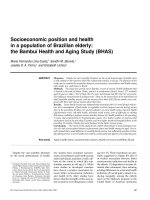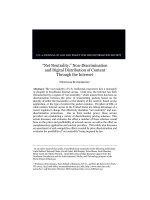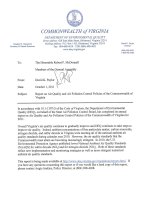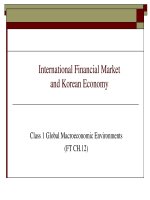International Financial Market and Korean Economy fiscal policies of korea through the GFC
Bạn đang xem bản rút gọn của tài liệu. Xem và tải ngay bản đầy đủ của tài liệu tại đây (473.57 KB, 43 trang )
International Financial market and Korean Economy
Class Note 11
Fiscal Policies of Korea through the GFC
* This material is based on Seok-Kyun Hur and Sungtae Kim (ERIA Fiscal Project,
2011).
I. Introduction
II. Assessment of Fiscal Position: Before and After the
GFC
III. Impact of Fiscal stimulus Package, Exit Strategy,
and Identification of Future Fiscal and
Macroeconomic Risk
IV. Fiscal Transparency and Anticipating Policy for
Future Crisis
V. Concluding Remarks
2
I . Introduction
Purpose to study
—
—
—
To examine whether these unusually expansionary (from
a long history of fiscal conservatism in Korea) fiscal
policy contributed to the quick recovery from the crisis.
To evaluate so called “the exit plan” of Korean
government from a fiscal side and forecast whether the
plan will retrieve fiscal balance effectively.
To identify potential risk factors on various fiscal areas
and suggests long-term measures for them.
3
II . Assessment of Fiscal Position: Before and After
the GFC
1.
Size and Composition of Fiscal Stimulus
Fiscal stimulus Packages (% of GDP)
Revenue measures
Permanent tax cuts
Temporary measures
Expenditure measures
2009 revised budget
- SOC expansion in regional areas
- Support for SMEs and self-employed
- Support for low-income households
- Local government support
- Other
2009 supplementary budget
- Support for low-income households
- Support for SMEs and self-employed
- Support for employment
- Local government support
- Green growth and other investment spending
Total
2009
-1.0
-0.7
-0.3
2.6
1.0
0.4
0.3
0.1
0.1
0.1
1.7
0.4
0.4
0.3
0.3
0.2
3.6
2010
-1.2
-1.0
-0.2
1.2
4
Source: Leif Lybecker Eskesen, “Countering the Cycle – The Effectiveness of Fiscal Policy in Korea”, WP/09/249, IMF, 2009.11.
II . Assessment of Fiscal Position: Before and After
the GFC
The estimated size of Fiscal Stimulus Package in Korea
varies from a source to another.
An official report from MOSF (April, 2010) confirmed that the size
of fiscal stimulus package was 38.8 tril. won (3.6% of GDP) in 2009.
It also announced that additional 17.1 tril. won (1.5%) would be
used in 2010.
These figures are very close to the pervious table (reminded that
the current GDP of Korea approximately amounts to 1,000 tril.
won).
The fiscal stimulus package consists of various fiscal items
but seems to concentrate more on tax cut, SOC building and
support for SMEs and self-employed.
These are the items known to have bigger or more persistent
multiplier effects.
5
II . Assessment of Fiscal Position: Before and After
the GFC
2.
Size of “Discretionary” Fiscal Stimulus
FI and FIS
Fiscal stimulus package
Automatic stabilizer and discretionary policy
Though conceptually clear, it is a very intriguing
task to decompose changes in fiscal variables into
the two parts empirically.
FI and FIS, which are commonly used as proxies for
“discretionary” fiscal stimulus for their simplicity.
6
II . Assessment of Fiscal Position: Before and After
the GFC
2.
Size of “Discretionary” Fiscal Stimulus
FIS
(the IMF method (Heller et. al. (1986) and Lee [2006]))
First, find a point of time, at which real GDP is closest to potential
GDP or GDP gap is almost zero.
At the point of time, the ratios of government revenue to GDP and
expenditure to GDP, respectively : t0 ≡ T0 / y0 , g 0 ≡ G0 / y0
Cyclically neutral balance : Bn ≡ t 0 y − g 0 y *
, where y is a real GDP and * potential GDP.
y
Fiscal stance is regarded neither expansionary nor contractionary
when revenue grows at the speed of real GDP while expenditure at
the speed of potential GDP.
Thus, by taking the difference between the cyclically neutral balance ( Bn
) and the current fiscal balance ( B ), IMF devises a measure of fiscal
stance called FIS in abbreviation.
FIS ≡ Bn − B
7
II . Assessment of Fiscal Position: Before and After
the GFC
2.
Size of “Discretionary” Fiscal Stimulus
FI
(the IMF method (Heller et. al. (1986) and Lee [2006]))
Sometimes it would be more useful if there is a measure comparing
the current fiscal stance with the previous one.
For the purpose, Fiscal Impulse (FI) indicator is suggested in the ratio
of FIS change to potential GDP.
Thus, the signs of FI are interpreted similar to those of FIS.
FI ≡ ∆ ( FIS / y * )
8
II . Assessment of Fiscal Position: Before and After
the GFC
2.
•
Size of “Discretionary” Fiscal Stimulus
These two measures confirm that fiscal stimulus package of Korea
concentrated on the period between 2009 Q1~2009 Q2.
Fiscal Stance (FIS) Fiscal Impulse (FI),
and Real GDP Deviation
15%
FIS
10%
FI
ln(rGDP_det)
5%
0%
-5%
-10%
-15%
I
II III IV I
II III IV I
II III IV I
II III IV I
II III IV I
2005
2006
2007
2008
2009
II
2010
9
II . Assessment of Fiscal Position: Before and After
the GFC
For comparisons with FI and FIS, estimate a SVAR following
Blanchard and Perotti(2002) with three different
identification strategies.
Tt
tt
X t = A(L )X t −1 + U t , X t ≡ Gt , U t ≡ g t
Y
y
t
t
–
–
–
where, Yt real GDP, Gt government expenditure,
and Tt tax revenue.
All of them are logarized after being divided by population
size and are seasonally adjusted and detrended by HP-filter.
A reason for detrending all the variables is because we would
like to focus on business cycles not on long-term non-stationary
10
movements.
II . Assessment of Fiscal Position: Before and After
the GFC
1)
The first identification strategy is simple Cholesky
Decomposition, which restricts U t
t t 0 0 0 t t 1
g
0
0
0
≡
t
g t + b1
y 0 0 0 y c
t
t 1
2)
0
1
c2
0 e t t
g
0 e t
1 e y t
Second, as a typical example of institutional
identification strategies, we adopt Blanchard and
Perotti (2002), whose shock identification is represented
as
tt 0 0
gt ≡ 0 0
y γ γ
2
t 1
α 3 t t 1 a 2
β 3 g t + b1 1
0 y t 0
0
0 e t t
g
0 e t
1 e y t
11
II . Assessment of Fiscal Position: Before and After
the GFC
3)
The third identification strategy, utilizing the
institutional information, borrows the restrictions on β1
and (β 3 =0) from the budget data in addition to α 3 , based
on the almost common perception that the government
of Korea has kept the principle of “Expenditure within
Revenue” since 1980s (Koh[2002]).
t
t t 0 α 2 α 3 t t 1 0 0 e t
g
g t ≡ β1 0 β 3 g t + 0 1 0 e t
y γ
y
t 1 γ 2 0 yt 0 0 1 e t
Based on the estimates from the above SVARs, I
calculate orthogonal shocks in tax revenue and
expenditure and define them to be the second measures
12
for discretionary fiscal policies.
II . Assessment of Fiscal Position: Before and After
the GFC
Correlations among the Measures of Discret. Fiscal Stimulus
Identification
Strategy I
Identification
Strategy II
Identification
Strategy III(#)
Discret.
Tax
Discret.
Exp
Discret.
Tax
Discret.
Exp.
Discret.
Tax
Discret.
Exp.
FIS
-0.25
0.32+
-0.27
0.30
-0.25
0.30
FI
-0.08
0.43**
-0.11
0.42***
-0.08
0.42***
Discret. Fiscal
Stimulus
Identification
Strategy I
Identification
Strategy II
Identification
Strategy III(#)
FIS
0.35+
0.33+
0.36***
FI
0.45**
0.44**
0.45**
Note: (1) ** , *** and + is significant at the 5%, 10% and 15% levels or better, respectively.
(2) Identification Strategy 3(#) assumes the fiscal stance of spending within revenue.
13
II . Assessment of Fiscal Position: Before and After
the GFC
Identification Strategy III
14
II . Assessment of Fiscal Position: Before and After
the GFC
The left graph indicate that automatic stabilizer(=t-e(t))
works slightly stronger against the discretionary
part(=e(t)) in revenue side.
Tax Bases are mostly the performances (earnings) in the previous
year.
On the other hand, the right hand side graph shows comovement of the automatic stabilizer(=g-e(g)) and the
discretionary spending expansion(=e(g)) in expenditure
side.
15
II . Assessment of Fiscal Position: Before and After
the GFC
3.
Fiscal expenditure vs. tax cuts
Tax cuts are known to have more persistent effect than
expenditure increase.
Tax cuts tend to last at least for a few years.
It is inferred that most tax reductions or deductions centered around
corporate investments or on the purchase of durable goods, which are
likely to have longer lagging and spill-over effects.
Compared with the current expenditure, capital expenditure
and tax reduction seem to have more persistent impact on
the economy.
According to S. Kim (1997), the government investment tends to boost
private economic activities whereas the government consumption is
likely to crowd out them.
However, the current expenditure has greater one shot impact.
For more details, refer to Appendix D.
16
III . Impact of Fiscal Stimulus Package, Exit strategy, and
Identification of Future Fiscal and Macroeconomic Risk
1.
Evaluate the effectiveness of fiscal stimulus combating
an economic crisis
Growth Contribution by Components
(%p)
10
8
6
4
2
0
-2
-4
-6
-8
-10
I
II III IV I
II III IV I
II III IV I
II III IV I
II III IV I
II III IV
2005
2006
2007
2008
2009
2010
Consumption
Source: Bank of Korea
Investment
Net Export
GDP
17
III . Impact of Fiscal Stimulus Package, Exit strategy, and
Identification of Future Fiscal and Macroeconomic Risk
From 2008 Q3 to 2009 Q3, each component of the
national income contributed to economic growth in the
following order.
Net Export > Consumption > Investment
Rapidly depreciating Won (Korean currency) improved trade
balance dramatically.
In the meantime, substantial investment from the government
sector counteracted fallen private investment.
18
III . Impact of Fiscal Stimulus Package, Exit strategy, and
Identification of Future Fiscal and Macroeconomic Risk
Since 2009 Q4, domestic components led the economic
recovery of Korea replacing trade sectors.
This may be a sign of lagged boosting effect from the
fiscal stimulus package, considered that most of
fiscal stimulus package were concentrated before
2009 Q4.
On the other hand, equal or more credit could be
given to the outperformed trade sector in the
pervious periods.
19
III . Impact of Fiscal Stimulus Package, Exit strategy, and
Identification of Future Fiscal and Macroeconomic Risk
On the efficacy of fiscal policies in Korea, the existing
literature haven’t reached unanimous decision.
S. Kim (2007) extended Blanchard and Perotti(2002) by
including price variable and interest rate
He used the consolidated fiscal data.
Either side of fiscal policies are not sustained.
W. Kim (2006) applied the method of Blanchard and
Perotti(2002) to the data of Bank of Korea Monthly Bulletin.
Both expenditure increase and tax cuts seem to have
boosting effects.
Tax cuts tend to have more persistent effects.
For the older literatures, refer to Appendix C.
20
III . Impact of Fiscal Stimulus Package, Exit strategy, and
Identification of Future Fiscal and Macroeconomic Risk
Contribution of Fiscal Stimulus Package to GDP Growth
2009(p)
2010(p)
2nd
half
Year
1st
half
2nd
half
Year
1/4
2/4
1st
half
Real GDP growth rate (%)
(A)
-4.3
-2.2
-3.2
3.5
0.2
7.6
4.86
6.1
Contribution of Fiscal
Stimulus Package (%p) (B)
1.2
1.7
1.4
1.1
1.3
0.7
0.3
0.5
Real GDP growth rate in
absence of Fiscal Stimulus
Package (%) (A-B)
-5.5
-3.9
-4.6
2.4
-1.1
6.9
4.3
5.6
Note: (1) (p) is preliminary .
(2) All the figures measure year-on-year changes (Unit: %, %p).
21
III . Impact of Fiscal Stimulus Package, Exit strategy, and
Identification of Future Fiscal and Macroeconomic Risk
The simulation results of evaluating the effects of the
fiscal stimulus package using KDI macroeconomic
model, which consists of 17 simultaneous equations
Expansionary fiscal policy such as supplementary budget and
extended tax exemption and reduction during GFC, contributes to
boost economic growth in 2009~2010.
For example, contribution of fiscal stimulus on real GDP growth in
the first half in 2009 was 1.4%p and in the second half was 1.1%p.
It is assessed that fiscal stimulus had a major role for Korean
economy to record positive growth rate in 2009.
In addition, the effect of fiscal stimulus continued in 2010, but it
became weaker than previous year.
22
III . Impact of Fiscal Stimulus Package, Exit strategy, and
Identification of Future Fiscal and Macroeconomic Risk
2.
Is the exit strategy clearly laid out?
On September 28th, 2010, the Cabinet meeting passed [The Medium
term Fiscal Management Plan for 2010~2014].
Medium Term Fiscal Balance
2010
Consolidated Public Sector
∆2.0
Finance Balance
(∆0.2)
(% of GDP)
Social Security
28.1
Contribution Balance
Operational Budget
∆30.1
Balance
(∆2.7)
(% of GDP)
2011
2012
2013
2014
5.0
(0.4)
18.0
(1.3)
27.4
(1.9)
37.9
(2.5)
30.3
32.3
33.7
35.2
∆25.3
(∆2.0)
∆14.3
(∆1.1)
∆6.2
(∆0.4)
2.7
(0.2)
23
III . Impact of Fiscal Stimulus Package, Exit strategy, and
Identification of Future Fiscal and Macroeconomic Risk
2.
Is the exit strategy clearly laid out?
Prospect for National Debt (2010~2014)
2010
(Unit: Tril. won)
2011
2012
2013
2014
Budget
Forecast
Public Debt
(% of GDP)
407.2
(36.1)
400.4
(34.7)
436.8
(35.2)
468.1
(35.1)
485.7
(33.8)
492.2
(31.8)
Liabilities for Debt
Financing
(% of Public Debt)
196.2
(48.2)
200.0
(50.0)
221.0
(50.6)
236.5
(50.5)
242.4
(49.9)
238.7
(48.5)
Financial Liabilities
(% of Public Debt)
211.0
(51.8)
200.3
(50.0)
215.8
(49.4)
231.6
(49.5)
243.3
(50.1)
253.5
(51.5)
Source: MOSF (2010).
24
III . Impact of Fiscal Stimulus Package, Exit strategy, and
Identification of Future Fiscal and Macroeconomic Risk
2.
Is the exit strategy clearly laid out?
Korean government declared a number of specific exit strategy to
secure fiscal sustainability via budget for fiscal year 2011 and the
MFMP for 2010~2014.
1.
2.
3.
A soft fiscal rule is temporarily introduced until operational fiscal
deficits returns to balance in 2014.
The keynote of fiscal policy moves to improvement of efficiency of
expenditure from encouragement of advance expenditure.
For tax exemption and reduction, the government will strictly manage
the scope and level based on assessment and will confirm if initial
objectives are still meaningful.
(Unit: 100mil. KW)
2006
2007
2008
2009
National Tax Exemption and
Reduction(A)
213,380
229,652
287,827
283,968
National Tax Revenues(B)
1,380,443
1,614,591
1,673,060
1,646,382
National Tax Exemption and
Reduction Ratio(A/(A+B))
13.4%
12.5%
14.7%
14.7%









